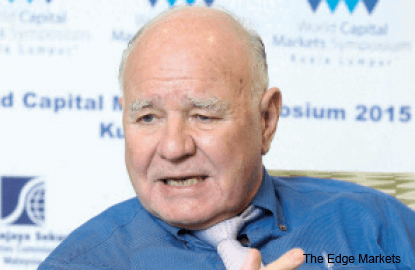
This article first appeared in Personal Wealth, The Edge Malaysia Weekly, on Sept 28 – Oct 4, 2015.
While the US dollar has strengthened considerably, its run is not expected to continue over the long term, says contrarian investor Dr Marc Faber. He suggests looking at undervalued Asian stocks that pay good dividends.

NOW is the time to buy battered-down dividend-yielding stocks in Asia, says Dr Marc Faber, contrarian investor and publisher of the widely followed Gloom, Boom & Doom report. His rationale: in the long term, these Asian stocks offer better dividend yields than fixed deposits or currencies such as the US dollar.
“Markets are already weak, especially in Asia. Malaysian stocks, in dollar terms, are 30% to 40% lower from the peak [adjusted for the currency]. And they may go lower. I remember stocks being at lower prices than what they are now,” he says in an interview during the World Capital Markets Symposium 2015, organised by the Securities Commission Malaysia, that was held on Sept 3 and 4.
“I can buy Maybank [stock, for example] with a dividend yield of 5%. How much will you get from the bank if you put [money in], say, a one-year deposit? 3%? It is better to own the bank than the deposit.”
While the US dollar has strengthened considerably against other currencies, the 69-year-old Swiss does not foresee the greenback continuing its run over the longer term.
“So, first of all, the dollar has to appreciate against Maybank [for example] by at least 5% per annum to break even because of the yield differential. That is the bet I am not willing to make over the next five years. If [your investment horizon is] one year, [then it is good] to be cash US dollars vis-à-vis being in Maybank. But over 10 years, you could make much more money in Maybank.”
On the flipside, Faber advises against holding any technology stocks because of their vulnerable and erratic nature. “Well, I think there is hype in biotech stocks in the US, tech stocks in general and specifically social media stocks. I think these are vulnerable areas … [but] tech has always been a driver of productivity and innovation.”
However, in the last few technology cycles, things have not always been well for the sector and its stocks, he says.
“In the late 1960s, it was [all about] mainframe computers and semiconductors [before] the whole thing collapsed. Then came mini-computers, and these also collapsed. In the 1990s, the internet boom came and 80% of these companies are [now] gone. In 1990, Cisco went public, and it was a success story until 2000. Dell was a huge success until 2000. After that, [these stocks] weren’t great stories.
“We all agree that technology is driving the world, or the world is driving technology. But it is also very fickle. Look at Netscape — where is it today? [Look at] AOL and Time Warner. Yahoo! hasn’t performed well in the long run.
“There are new companies coming up, but you and I don’t know whether the world will still be using Facebook in five years. I mean they will use it, but to what extent will it make money and to what extent will it still grow? By then, everybody in the whole world would have a Facebook [account] and to grow [further] would be more difficult. So, it is difficult to invest in technology.”
Some industry experts say “cash is king” and recommend that investors hold large amounts of cash in volatile times. Faber, however, advises against this strategy, saying that it is too risky to hold only cash.
“As an investor, there are recommendations to go 100% into cash, but I disagree with that notion to some extent. First of all, most people can sell shares, but to sell your house? It is illiquid.
“The other issue which comes up is if you sell everything and you are wrong, what then? I would be very reluctant as an investor to just hold cash. First of all, it will cost you, say, 5% minimum in transaction costs on all your assets. To buy again will cost you another 5% at least.”
Instead, investors would do well to stay invested and diversified to ride out market volatility.
“One of the most important insights for an investor is to understand is that no matter how intelligent he is, he doesn’t know what the world will look like in 5 or 10 years. He has to diversify,” Faber says.
“He has to own some real estate, some shares. He may hate bonds, but I think bonds will be better investments than US stocks or stocks [in general]. For diversification, I would hold some bonds, some cash overseas and also some precious metals, such as gold, silver and platinum.”
Art is something investors should consider for their portfolio. “If someone likes art, [he can consider it]. A lot of people have become very rich through art because they collect artists who have become very well known,” he says.
“Currently, there is a lot of speculation in the art market. But I would imagine that in many countries, there are many unknown artists. One day, they will have a chance to become famous. They don’t have to be famous globally — just in their own markets. So, hold a portion in art, but be aware that you can also lose your art through theft.”
Save by subscribing to us for your print and/or digital copy.
P/S: The Edge is also available on Apple's AppStore and Androids' Google Play.